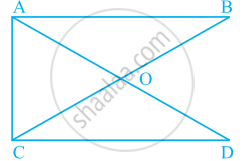Advertisements
Advertisements
प्रश्न
An exterior angle of a triangle is equal to 100° and two interior opposite angles are equal. Each of these angles is equal to
विकल्प
75°
80°
80°
40°
50°
उत्तर
n the ΔABC, CD is the ray extended from the vertex C of ΔABC. It is given that the exterior angle of the triangle is 100° and two of the interior opposite angles are equal.
So, ∠ACD = 100° and A = ∠B

So, now using the property, “an exterior angle of the triangle is equal to the sum of the two opposite interior angles”, we get.
In ΔABC
∠A + ∠B = ∠ACD
∠2A = 100°
`∠A = (100°)/2`
∠A = 50°
∠A = ∠B = 50°
Therefore, each of the two opposite interior angles is 50°.
APPEARS IN
संबंधित प्रश्न
In a ΔABC, ∠ABC = ∠ACB and the bisectors of ∠ABC and ∠ACB intersect at O such that ∠BOC = 120°. Show that ∠A = ∠B = ∠C = 60°.
Can a triangle have two acute angles?Justify your answer in case.
Calculate the unknown marked angles of the following figure :

Find the value of the angle in the given figure:

Find x, if the angles of a triangle is:
x°, 2x°, 2x°
The length of the sides of the triangle is given. Say what types of triangles they are 3.7 cm, 3.4 cm, 4 cm.
Find all the three angles of the ΔABC
Q is a point on the side SR of a ∆PSR such that PQ = PR. Prove that PS > PQ.
S is any point on side QR of a ∆PQR. Show that: PQ + QR + RP > 2PS.
The number of triangles in figure is ______. Their names are ______.
